Previously OnView @ Central
Helen and Newton Harrison: California Work
September 21, 2024 - January 19, 2025
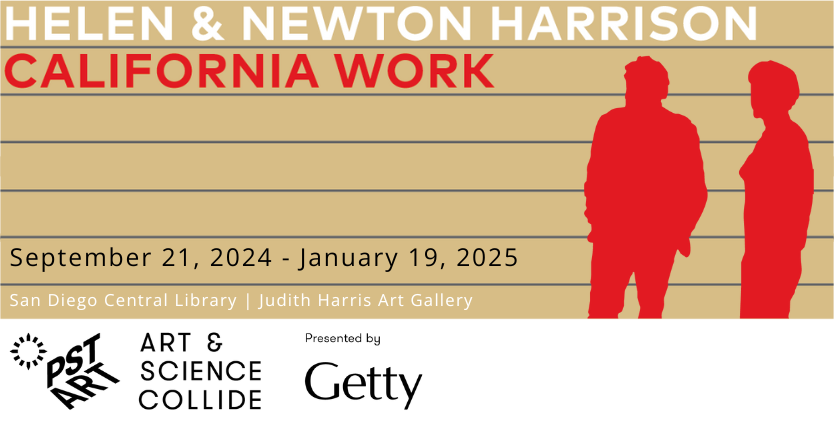
As part of the Getty Foundation’s Pacific Standard Time: Art and Science Collide, the San Diego Public Library’s Visual Arts Program presents Helen and Newton Harrison: California Work, a retrospective exhibition about the work of husband-and-wife team Helen Mayer and Newton Harrison, who were among the earliest and most notable ecological artists. Founding members of the Visual Arts Department at UC San Diego, Helen and Newton were local San Diego artists for nearly four decades, where they developed their pioneering concepts of Ecological Art.
Helen and Newton Harrison: California Work is the first exhibition to focus on their California work, including nearly 20 projects produced between the late 1960s and 2000s. Presented as a multi-site exhibition in four locations around San Diego simultaneously, the exhibitions will examine the California works produced including: Urban Ecologies, The Prophetic Works, Saving the West, and Future Gardens.
Saving the West, presented at the San Diego Central Library will allow visitors to delve deeply into the series of works associated with the Harrisons’ research on the fragile and environmentally threatened ecologies of the Pacific Coast fog forest and the Sierra Nevada mountains. These bioregional works, mark the Harrisons’ growing interest in complex ecologies, the impacts of overexploitation and mismanagement of natural resources and the effects of global warming on the complex bionetworks of forests and watersheds. Works reveal the Harrisons’ concept of the Force Majeure and their increasing concern with the issue of global climate change.
Curated by Tatiana Sizonenko, PhD.
About Pacific Standard Time 2024
The third regional collaboration in the Getty series, PST ART: Art & Science Collide, will focus on the intersection of science and art. Exhibitions will explore subjects ranging from ancient cosmologies to indigenous sci-fi and from environmental justice to artificial intelligence. Art & Science Collide will share groundbreaking research, create indelible experiences for the public, and generate new ways of understanding our complex world.
For more information about PST ART: Art & Science Collide, please visit pst.art
James Hubbell: Architecture of Jubilation
March 9, 2024 - August 4, 2024
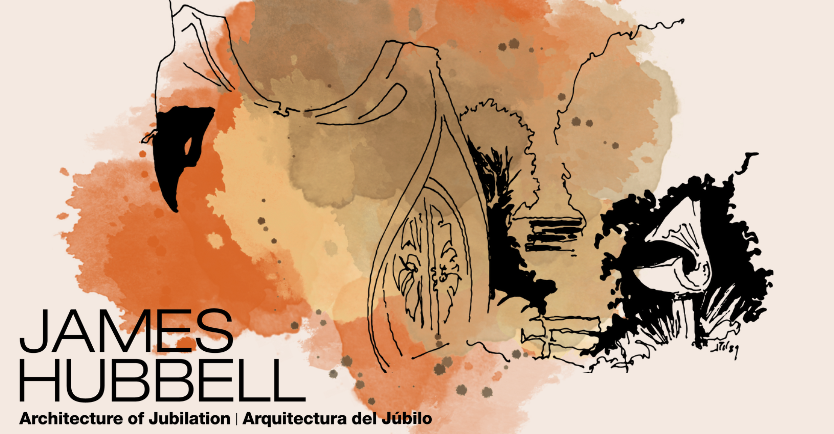
In southern California, between the influences of San Diego, Tijuana and the Pacific; among mountains, manzanita, boulders and oaks, lives a man who builds a world he wants to live in - where the aesthetic is a reflection of nature - and philosophy and art are a way of life. Artist James Hubbell has a 70-plus-year career as a contemporary master who expresses himself through nature-inspired art, architecture and functional objects and spaces. Using stone and glass, paint and pen, wood and steel, his works are natural and unconfined. His human and nature-centric design places art in walls, roofs, floors, and furnishings, not separate from, but as extensions of life. In Hubbell’s world, the everyday is elevated to art, and art is for every day.
Hubbell recognizes that it is our cities, buildings, structures - our treatment of our environment -that are perhaps our truest expressions of our views and values, our understanding of the ordering of the universe in which we live. Without great fanfare or financial reward, James Hubbell, the non-architect builder, personally led the design and construction of multiple architectural and fine art projects that accomplished meaningful social and educational transformation in Tijuana and San Diego.
Architectural designer, sculptor, painter, stained-glass artist, community activist - James Hubbell is one of San Diego’s most prolific artists. His Architecture of Jubilation - is an invitation for all of us to create the world we want to live in.
This exhibition was made possible by a collaboration between the San Diego Public Library, the San Diego Commission for Arts & Culture, the Library Foundation SD and the Ilan-Lael Foundation. This Project is an official community initiative of the World Design Capital San Diego/ Tijuana 2024.
San Diego Art Prize
October 28, 2023 - January 14, 2024
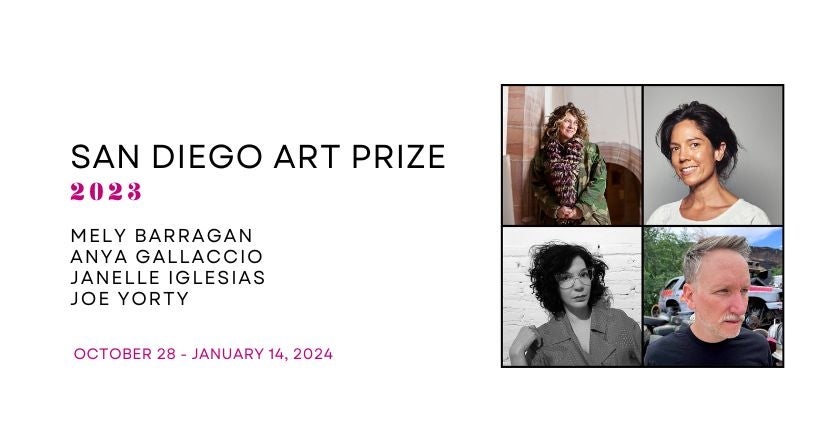
The San Diego Art Prize is predicated on the idea that the visual arts are a necessary and rewarding ingredient of any world-class city, and was conceived to promote and encourage dialogue, reflection, and social interaction around San Diego’s artistic and cultural life. This annual award honors artistic expression with a cash prize, exhibition opportunities, and spotlights artists in the San Diego to Ensenada, Mexico region whose outstanding achievements in the field of visual arts merit recognition.
The San Diego Visual Arts Network is pleased to announce the four recipients of the 2023 San Diego Art Prize: Mely Barragán, Anya Gallaccio, Janelle Iglesias, and Joe Yorty. Recipients were nominated by 17 local arts professionals and selected by an esteemed panel of curators from respected institutions: Pedro Alonzo - Adjunct Curator, Dallas Contemporary, Dallas, Texas, Susanna Temkin - Curator at El Museo del Barrio, New York, New York, Kathryn Kraczon - Director of Exhibitions of the Brown Arts Institute (BAI) and Chief Curator of the David Winton Bell Gallery at Brown University, Providence Rhode Island.
Curated by Lara Bullock, Ph.D.
Humanity Showers | Traveling Exhibit at San Diego Public Libraries
2023 - 2025

An ongoing documentary photography project; Jordan Verdin's Dignity on the Streets & Humanity Showers project is a shining example of the intersections of community service and the visual arts.
Brought to various San Diego Public Library locations, Humanity Showers offers the public a collection of over 300 oral histories and portraiture of individuals experiencing homelessness throughout San Diego County.
Behind the Scenes
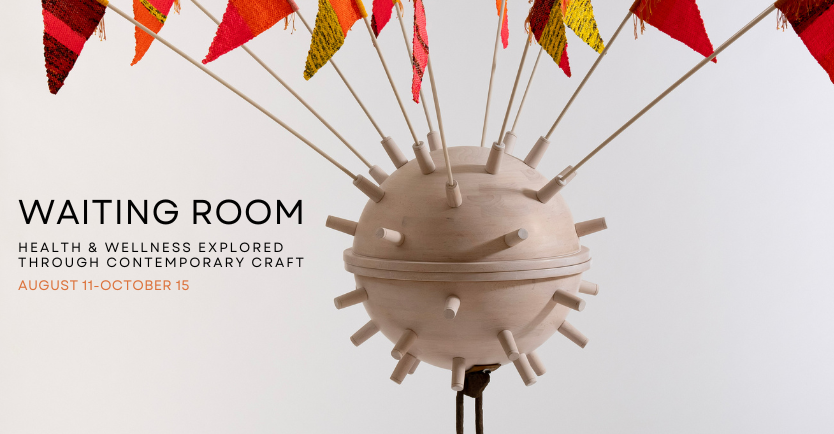
Waiting rooms act as physical objects of containment, an agent of transition, a boundary, or a threshold. Often these liminal spaces invite introspections into our mental, emotional, and physical worlds. What does it mean to care for something? Someone? Ourselves? Expressions of care—or the lack thereof—shape the world in which we live, a world that is often fraught with competing tensions and complexities.
Waiting Room seeks to unpack matters of illness, suffering, and healing. Explored through a range of artistic interpretations and processes including metalwork, fiber art, ceramics, glass and woodworking, the works on view investigate how we express emotional resilience. How we bring our whole selves into the consulting room. Articulated through contemporary craft, the conversation advances the important role of art in communicating our inner states. When something is internal and then externalized into a form, it frees us and allows both our physical and intangible selves to ponder, act, and address. It facilitates deep engagement with sensitive subjects and provides stimulus to influence understanding, liberation, and relief.
Curated by Bonnie R. Domingos and featuring works by Warren Bakley, Charlotte Bird, Richard Burkett, Judith Christensen, Polly Jacobs Giacchina, Linda Litteral, Viviana Lombrozo, Adam John Manley, Kathleen Mitchell, Michelle Montjoy, Kathy Nida, Christian Garcia-Olivo, Gail Schneider, Ross Stockwell, Cheryl Tall, and Vicotria Fu & Matt Rich.
Virtual Tour
Good Natured: Art & the Environment
May 13, 2023 - July 29, 2023

The laws of Nature are not separate from us. They are not a mysterious other; distant and intangible. At a time when vast amounts of scientific data are sounding the alarms of our current poly-crisis (ecology, economy, energy, and equity), our collective experiences implore us to reconsider our environmental impact and the need for reciprocity. Good Natured challenges us to act in this contingent world and ponders the question what it is to be both the problem and the solution.
Explored paradoxically, literally, ironically, and playfully, Good Natured artists make direct interventions; imaginative and unruly, others certain and precise. Manifested in various approaches and materials including painting, sculpture, textile, mixed media, and digital works, the exhibition provides a multisensory and immersive experience that challenges us to see nature and ourselves as sources of regeneration. A catharsis in an age of paralysis.
Curated by Bonnie R. Domingos and featuring works by Trevor Amery, Mariah Armstrong, Stephanie Bedwell, Taylor Chapin, Aaron Glasson, Sofia V. Gonzales, Judit Hersko, Bianca Juarez, Timothy Murdoch, Margaret Noble, Terri Hughes-Oelrich, Catherine Ruane, Tatiana Ortiz-Rubio, and Ruth Wallen.
Virtual Tour
Lost in Translation: A Game of Telephone
February 6, 2023 - April 15, 2023

Inspired in part by the current state of communication breakdown in our country, this exhibition examines the many ways we (mis)interpret or (mis)understand each other through a game of telephone with local artists and authors. The fascinating, touching and humorous interpretations that occur as words are rendered into images and back to words highlights how perception evolves. In a time when social media is rife with frustration and defensiveness, this project asks the participants to set aside judgement and respond to another's world view with compassion, curiosity and/or a sense of humor. Local curator Chi Essary teamed up with Julia Dixon Evans, writer and KPBS/Arts Producer to select and match local artists and authors to play a game of telephone over the last year. The exhibition reveals how these layers of interpretation end up wildly different or surprisingly similar to the beginning, analogous to the challenges we face as human beings to relate to one another.
Featuring works by Alanna Airitam, Wick Alexander, Animal Cracker Conspiracy, MR Barnadas, Phil Beaumont, Ryan Bradford, Carlos Castro, Patrick Coleman, Marisa Crane, Hugo Crosthwaite, De la Torre Brothers, Sheena Rae Dowling, Julia Dixon Evans, Corey Lynn Fayman, Max Feye, Charles Glaubitz, Lily Hoang, Ari Honarvar, Marianella de la Hoz, Lizz Huerta, Beliz Iristay, Lindy Ivey, Kirsten Imani Kasai, Kiik Araki-Kawaguchi, John Purlia, Guro Silva, Jackie Dunn Smith, Miki Vale, and Perry Vasquez.
Virtual Tour
SD Art Prize
September 17, 2022 - January 7, 2023
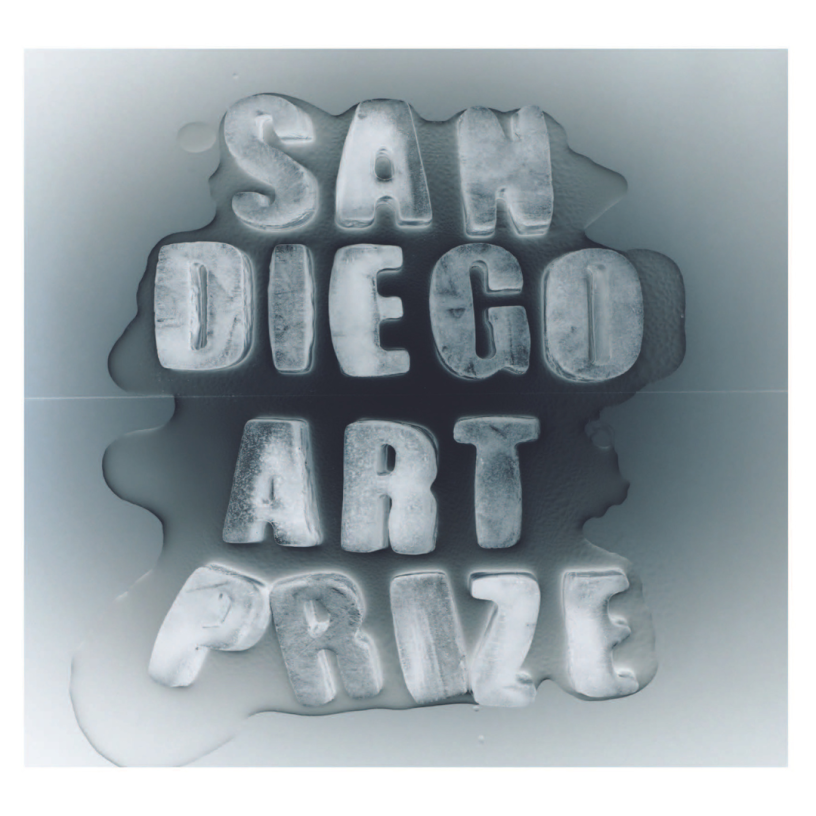
Dedicated to the idea that the visual arts are a necessary and rewarding ingredient of any world-class city, the SD Art Prize was conceived to promote and encourage dialogue, reflection and social interaction about San Diego’s artistic and cultural life. This annual award honors artistic expression with a cash prize, exhibition opportunities, and spotlights artists in the San Diego to Ensenada, Mexico region whose outstanding achievements in the field of visual arts merit recognition.
The San Diego Visual Arts Network is pleased to announce the four recipients of the 2022 San Diego Art Prize Alida Cervantes, Angélica Escoto, Carlos Castro Arias and Cognate Collective for being selected. Their outstanding creativity, dedication to their work and contributions to our region have made them stand out to the four national and international curators who selected them from the nominations made by 17 local art professionals. This year we are thrilled to introduce the four national and international curators from respected institutions who selected the four recipients. From the San Francisco Museum of Modern Art - Jovanna Venegas, Assistant Curator of Contemporary Art Whitney Museum, New York - Marcela Guerrero, Assistant Curator Frost Art Museum, Florida - Amy Galpin, Chief Curator Mexico City & Vienna, Austria - José Springer, Independent Curator.
Echoes of Africa
June 4, 2022 - August 20, 2022
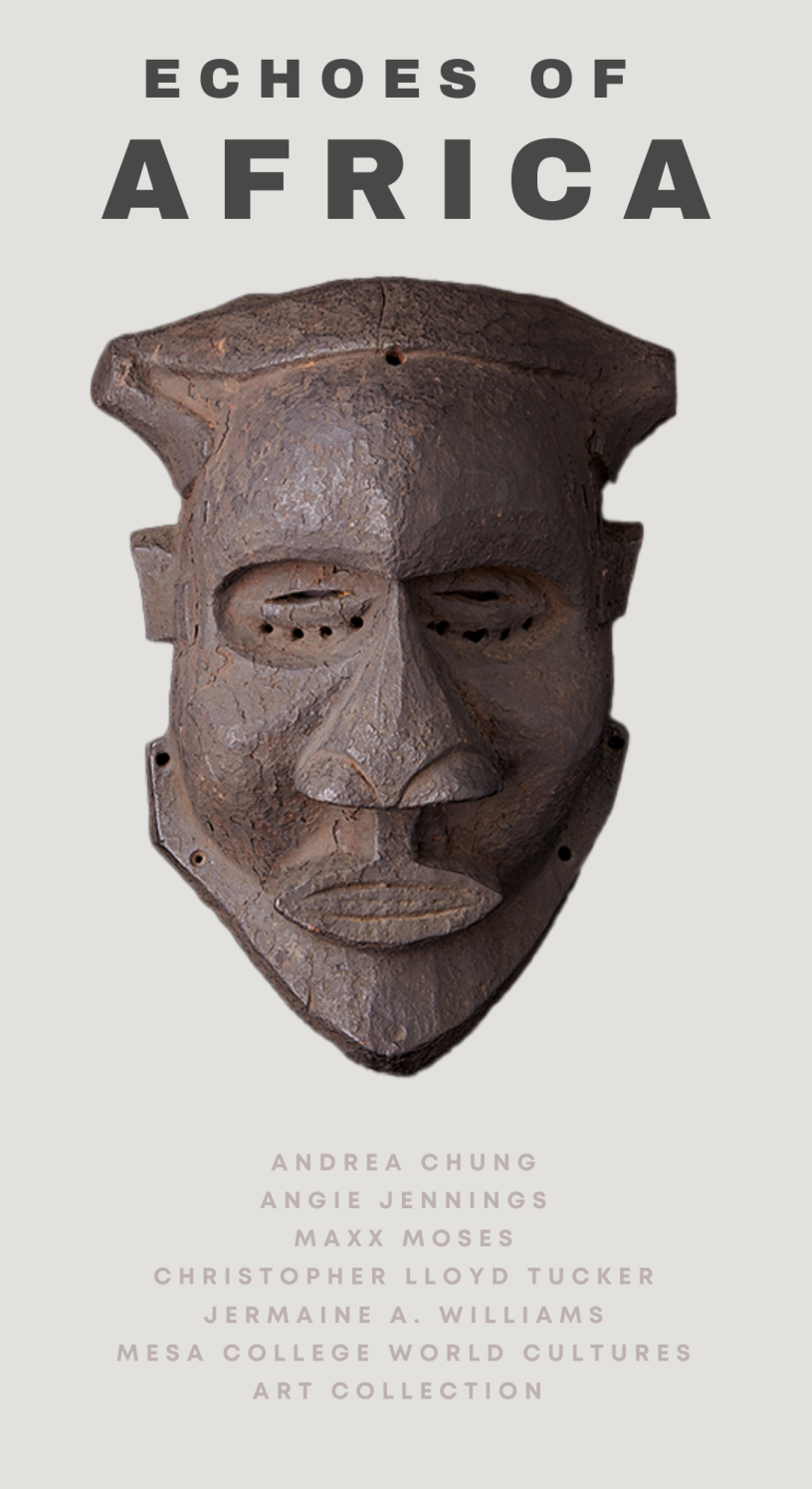
Echoes of Africa celebrates classical and contemporary artistic traditions by African and African American artists. This two-part exhibition features African artifacts from San Diego Mesa College's World Cultures Art collection coupled with artworks produced by local contemporary artists. A dynamic group of artifacts will be exhibited, featuring objects that demonstrate the mastery of African artisans in metal, wood, ceramics, beadwork, and textiles. The Fine Arts gallery will highlight artworks by contemporary local artists in conversation with select African artifacts, echoing and responding to aspects of their materials, symbolism, and creative process. The exhibition pays tribute to the ongoing cultural and artistic influence of African art on African American artists and celebrates our connections to the spirit and history of African and African American culture.
Curated by Dr. Denise Rogers and features work by Andrea Chung, Angie Jennings, Christopher Lloyd Tucker, Maxx Moses, and Jermaine Adeshola Williams.
Virtual Tour
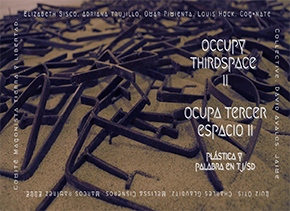
Occupy Thirdspace II: Plástica y palabra en TJ/SD explores the relationship between the visual arts and palabra (word). It documents the history of this relationship from the late 1980s to the present, through the work of artists who have lived and worked in Tijuana and San Diego. Palabra as a concept speaks back to the oppressive function of “Language,” as a tool for colonization, assimilation, and exclusion—repurposing, translating, and changing it. Plástica y Palabra represents a collective force of impulses that cross geopolitical, racial, lingual, social, and economic borders. These practices live, give new life, and assign new meaning to their environment.
Ocupa Tercer Espacio II: Plástica y palabra en TJ/SD explora la relación entre las artes visuales y palabra. Documenta la historia de esta relación desde fines de la década de 1980 hasta el presente, a través del trabajo de artistas que han vivido y trabajado en Tijuana y San Diego. Palabra como concepto responde a la función opresiva del "lenguaje," como una herramienta para la colonización, la asimilación y la exclusión—reutilizándolo, traduciéndolo y cambiándolo. Plástica y Palabra representa una fuerza colectiva de impulsos que cruzan fronteras geopolíticas, raciales, lingüísticas, sociales y económicas. Estas prácticas viven, dan nueva vida y asignan un nuevo significado a su entorno.
Curated by Sara Solaimani and features work by David Avalos, Elizabeth Sisco, Louis Hock, Omar Pimienta, Cog•nate Collective, Adriana Trujillo, Jaime Ruiz Otis, Charles Glaubitz, Melissa Cisneros, Marcos Ramírez ERRE, and Comité Magonista Tierra y Libertad.
Sonidero Travesura will be performing LIVE at the gallery opening. The duo is composed of Tijuana native Omar Lizarraga and Dardin Coria.
Behind the Scenes
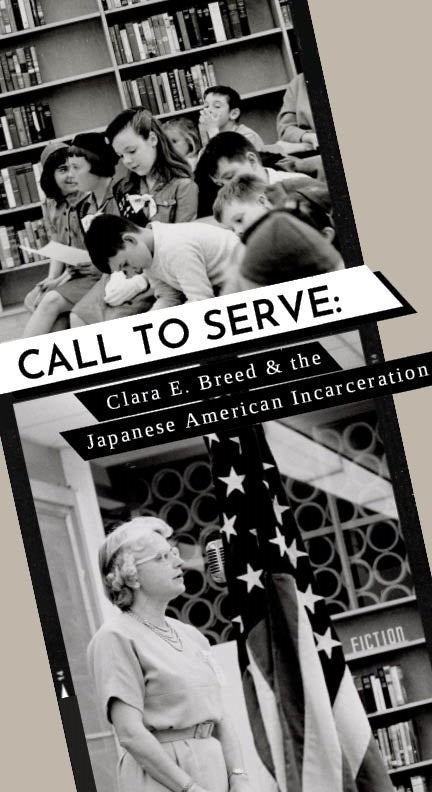
Clara E. Breed directed the San Diego Public Library for 42 years as a public servant advocating on numerous fronts, including the promotion of youth services, championing a child’s right to read by encouraging international and multicultural collections, undertaking an unprecedented expansion of the City’s Library system, and most significantly, advocating on behalf of the hundreds of Japanese American families that were incarcerated due to Executive Order 9066.
Breed was ahead of her time in her interest to promote cultural understanding and fight prejudice. Her steadfast commitment and activism broadens our insights about the role libraries play in working toward a more equitable, diverse, and inclusionary future.
Call to Serve: Clara E. Breed & The Japanese American Incarceration is co-organized by guest curators Susan Hasegawa, Linda Salem, and the San Diego Public Library. This exhibition was made possible by a collaboration between the City of San Diego Commission for Arts and Culture, the Japanese American National Museum, the Japanese American Historical Society of San Diego, San Diego State University Library, and Simmons University Archives. This project was made possible with support from California Humanities, a non-profit partner of the National Endowment for the Humanities.
Behind the Scenes
Exhibition Teaser
Virtual Tour
WW-II Japanese American Incarceration Camp Replica
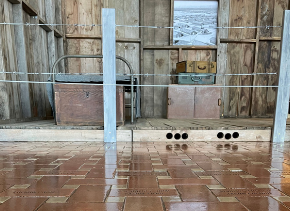
In 1942 the War Relocation Authority (WRA) had constructed ten centers in the harshest, most desolate places in California, Arizona, Utah, Colorado, Wyoming, Idaho, and Arkansas in order to house all persons of Japanese ancestry who were incarcerated as enemies of the state after the bombing of Pearl Harbor. Although there were no cases of spying or espionage by the Japanese immigrant community or their American-born children, approximately 120,000 persons of Japanese ancestry were forcibly removed from and imprisoned in barbed-wire fenced camps.
Like thousands of young men eager to serve in the military and fight in WW-II, Frank Wada (pictured) volunteered for the army. Born and raised in Southern California, Wada was one of the first volunteers out of Poston, Arizona Incarceration Camp located on the Colorado River Native American Reservation. Wada joined thousands of Japanese Americans to serve in the highly decorated 442nd Regimental Combat Team. Wada, his family and friends built this model barracks to tell the story of their WW- II incarceration.
This replica model, located on the ground floor lobby of the Central Library, was reconstructed as part of the Call to Serve: Clara E. Breed & the Japanese American Incarceration exhibition. This was made possible by the Wada Family. Special thanks to Frank Wada and his son, Greg Wada and Jeanne and Bill Elyea.
Fear No Art: Civic Engagement, Histories, Currencies
February 15 – May 17, 2020
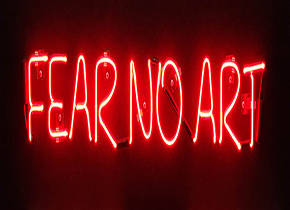
© City of San Diego Civic Art Collection
Virtual Tour
Behind the Scenes
Julius Shulman: Modern San Diego
September 28 – January 19, 2020
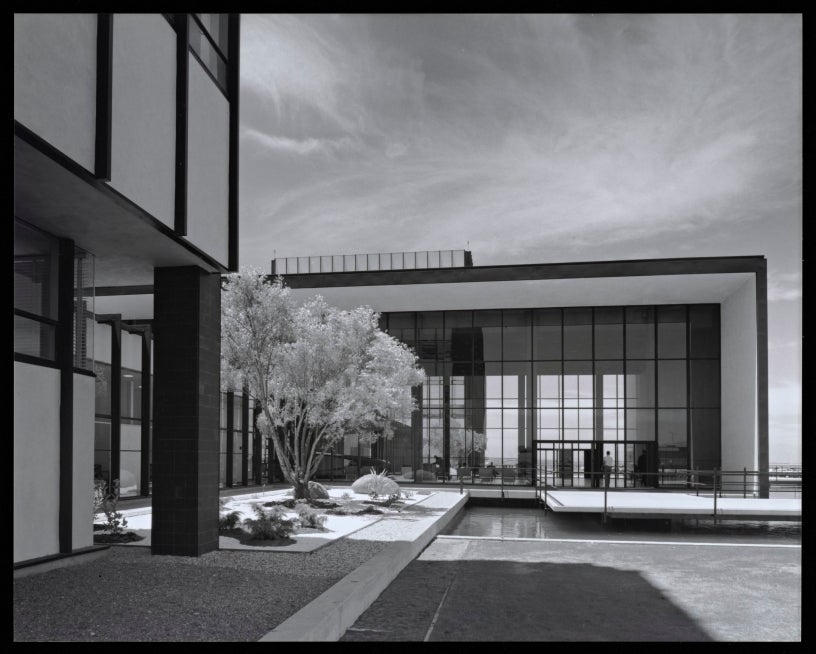
© J. Paul Getty Trust
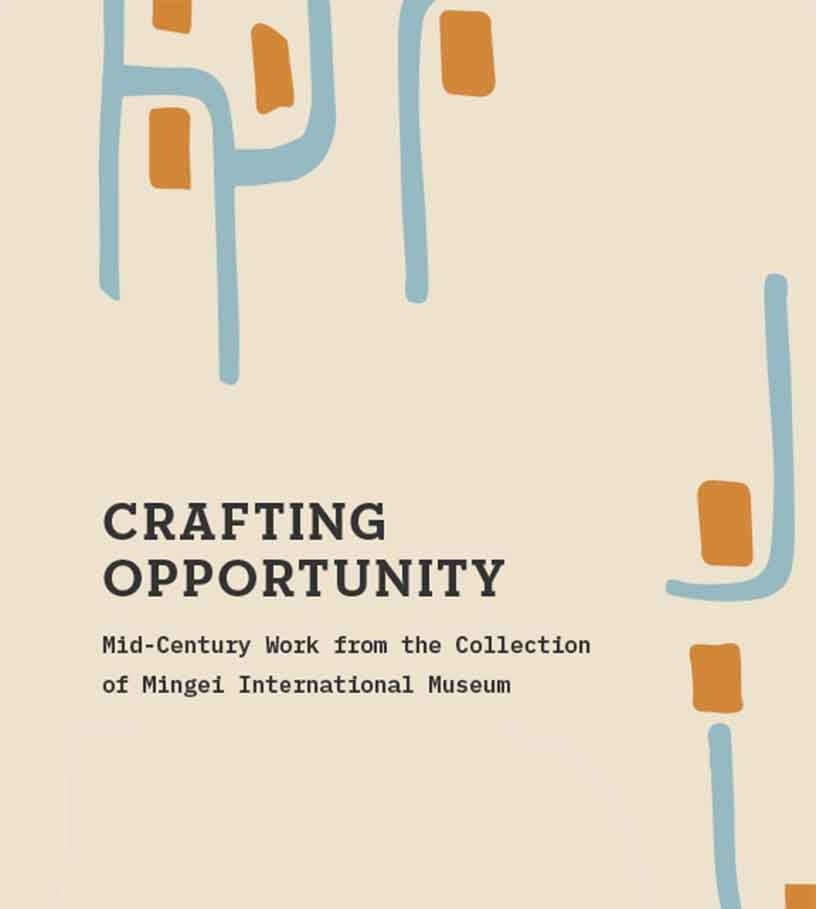
The Artist Portrait Project: San Diego Artists 2006-2016
Dec. 15, 2018 – March 17, 2019
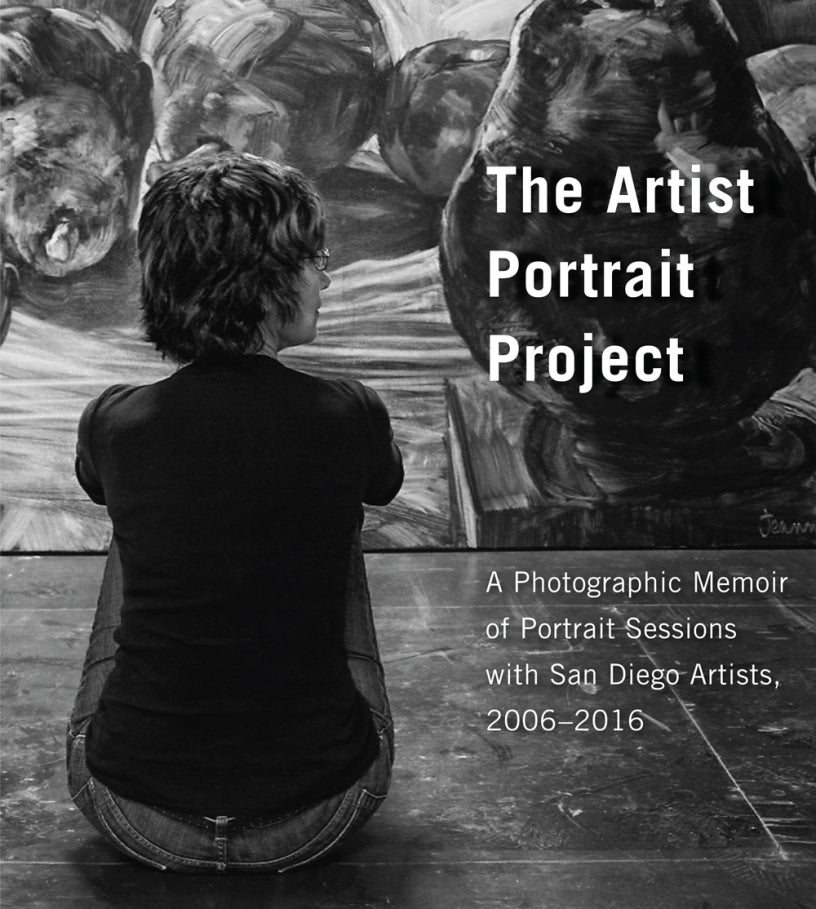
A Method for Reaching Extreme Altitude
May 26 - Sept. 16, 2018

You Are Here
Feb. 10 - May 6, 2018

Dream of the Nineties
Sept. 23 – Dec. 31, 2017
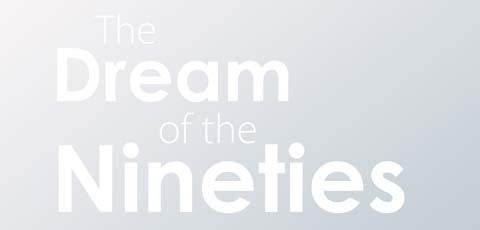
Weather on Steroids: the Art of Climate Change Science
June 10 - Sept. 3, 2017
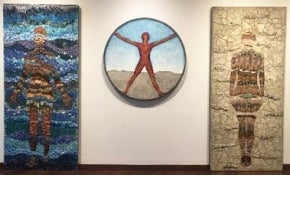
Print Culture: Midcentury Modern Graphic Design in San Diego
December 10, 2016 – May 7, 2017
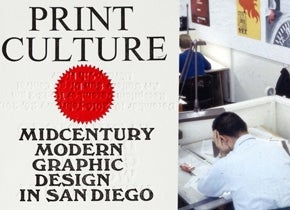
Print Culture showed fine graphic design created primarily in the 1950's and '60s by professional San Diego artists, many of whom made their living in the defense industry. Some of the works were produced for employers like Convair and NEL, others the artists created for their own purposes, such as greeting cards or print materials to promote their own work. Print Culture was more than an art experience; it was a study of graphic techniques from another era and a lesson in our region's history. Curated by Dave Hampton, featured artists included Bob Matheny, Tom Gould, Bill Noonan, John Baldessari, James Boynton, Barney Reid and Jim Sundell.
Intersecting Lines: The 11th Biannual Drawing Show
September 24 – November 27, 2016
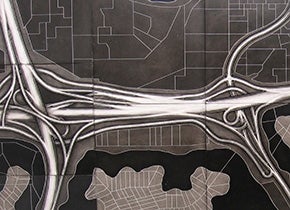
We humans have put ideas into form since the Stone Age. Drawings – scribbles and doodles to sketches and diagrams -- help make our ideas tangible and explain what words cannot. For studio artists, drawing is a fundamental skill, yet the concepts and media they explore and employ are limitless. This show offered thought-provoking, powerful works: anatomy lessons testified to an artist’s prolificacy, collaborative drawings served as artifacts of complex community investigations, figurative work referred to pop culture, political debates and the built environment. Featured artists: Joyce Cutler-Shaw, Dominic Paul Miller, Todd Partridge, Regan Russell, Barbara Sexton.
First Folio! The Book That Gave Us Shakespeare
June 4 – July 7, 2016
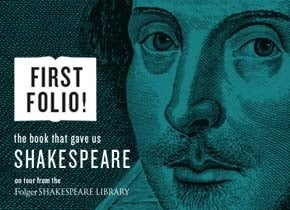
In 1623, Shakespeare’s friends collected the Bard’s works and published them in a single volume, known as The First Folio. Without it, 18 plays, including Macbeth and The Tempest, could have been lost. Today, the First Folio is considered one of the world’s most important books with only 235 surviving. The San Diego Public Library and The Old Globe co-hosted the Folio in its only California stop on a national tour organized by the Folger Shakespeare Library, Washington, DC. More than 10,000 visitors viewed the First Folio free of charge in the Art Gallery.
Portrait of Pomeroy
March 12 – May 15, 2016
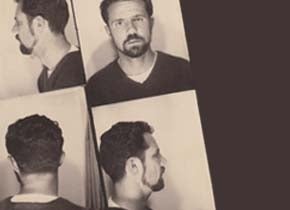
Library visitors were given access to one of the best-kept secrets of the San Diego art community: Walter Pomeroy’s extensive private collection of works by local artists of the 1950s and 1960s. Pomeroy encouraged young contemporary artists by purchasing from them directly. The resulting collection represents a who’s who of San Diego contemporary artists of the period. Curated by Dave Hampton, artists featured included Martha Alf, John Baldessari, Don Borthwick, Fred Cooper, Dan Dickey, Michael Dormer, Don Dudley, Robert Fries, Ethel Greene, Harold Gregor, Tom Gould, Ed Hatten, Fred Holle, Marj Hyde, Ellis Jacobson, Frank Jones, Dudley Kendall, Sheldon Kirby, Donna Leavitt, Mary Ellen Long, Mark-Elliott Lugo, Bob Matheny, Cliff McReynolds, Richard Allen Morris, Barney Reid, Sarah Roberts, Guy Williams, and Jackson Woolley.
Significant Others
December 19, 2015 – February 28, 2016

Significant Others was an exhibition of work from eight San Diego artists making up four married couples. The artworks on view were as diverse as the dynamics in each relationship. Some couples chose to work as collaborators; others pursued distinctly independent artistic practices and aesthetics. Featured artists included Jean Lowe and Kim MacConnel; Jessica McCambly and John Oliver Lewis; Debby and Larry Kline; and Anna O’Cain and Richard Keely.
Rainmaker
September 19 – November 29, 2015
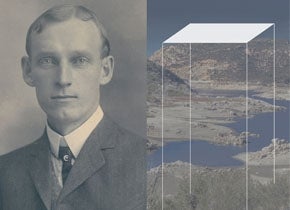
Works in this exhibit commemorated an unusual moment in our arid region's history and explored the element of water: its presence and absence, its mystery and allure, and the futility and absurdity of our attempts to control it. In 1915, San Diego‘s City Council accepted Charles Hatfield’s offer to make rain; it then poured more than 30 inches in four weeks, wiping out dams, homes and bridges. In 2015, twelve San Diego artists filled the gallery with watery sounds, sculpture, painting, poetry, photography, video and digital animation. Artifacts related to Charles Hatfield were also on view. The exhibition was curated by Susan Myrland and featured Adam Belt, Roman de Salvo, Michael Field, Lisa Hutton, Gabriel Kalmuss-Katz, Dominic Paul Miller, Margaret Noble, Scott Polach, Eva Struble, Joshua Tonies, Jim Wilsterman, and Sheldon Wood.
The Art of Comic-Con
June 20 – September 6, 2015
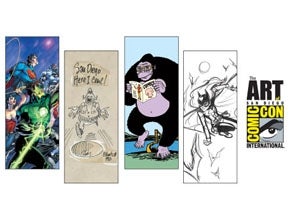
Since the first convention held in San Diego 45 years ago, Comic-Con has been bringing together comics, movie, and science fiction fans, and creating a lot of great art along the way. Providing unprecedented access to original art by over 60 comics artists, The Art of Comic-Con traced the history of Comic-Con through art and provided a sneak peek into the evolving process of creating comic art. Drawing from Comic-Con's archives, the exhibition highlighted how art serves as an integral tool in promoting the organization’s mission of creating awareness of, and appreciation for, comics and related popular artforms.
[UN]BOUND: Artists’ Books from the Athenaeum Music and Art Library
January 31 – May 31, 2015
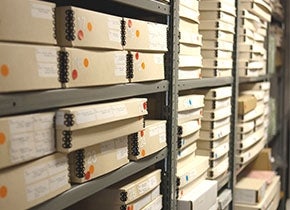
In 25 years of collecting, the Erika and Fred Torri Artists’ Books Collection at the Athenaeum has grown into an important resource for artists, researchers, and presses. In this exhibition, visitors had access to more than 50 of the Athenaeum’s rare and diverse books by 36 artists. From conceptual books of the late 1960s to 1970s to fine press limited editions and book objects, [UN]BOUND offered an unprecedented opportunity to discover the book as both object and idea in the hands of San Diego artists.
Hiding in Plain Sight: Eight Voices in Contemporary Photography
September 6, 2014 – January 11, 2015
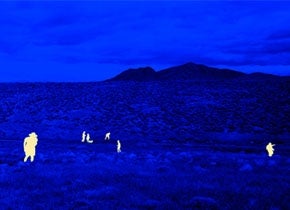
Hiding in Plain Sight examined the evolving state of contemporary photography, as new tools and new media inspire artists to rethink traditional photographic processes. Using techniques of collage, photographic sequencing, time, and persistence of vision, artists showed how the 175-year-old medium has been shaped into its present form and suggested that it is at the dawn of a new era. Curated by scott b. davis, featured artists included Andy Cross, Amanda Dahlgren, Judith Fox, John Brinton Hogan, Michael Mulno, Han Nguyen, Scott Polach, and Rebecca Webb.
Intersecting lines: The Tenth Invitational Drawing Show
April 26, 2014 – August 24, 2014
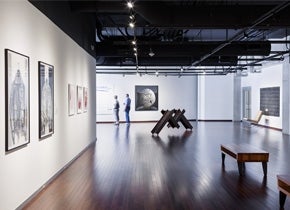
Drawing is deeper than lines on a surface, as demonstrated by the convergence of concept, media and process visible in this show. Seven artists challenged assumptions about the medium by working with unexpected materials, such as cut paper, acrylic and glass, as well as the traditional charcoal, ink and graphite. Featured artists included Joshua Eggleton, John Halaka, May‐ling Martinez, Jessica McCambly, Bhavna Mehta, Herbert Olds, and Marisol Rendón.
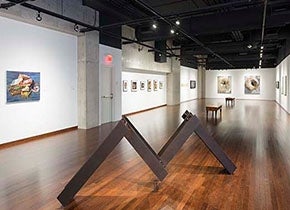
The first Gallery exhibit in San Diego’s new Central Library celebrated the past success of the Public Library’s Visual Arts Program, and marked a new beginning. The VAP was created by Mark-Elliot Lugo in 1997 and curated by him until 2012. The program demonstrated the library's role as a cultural institution embracing a broad range of disciplines while helping San Diego's mid‐career and older professional artists achieve wider attention. The exhibition was curated by Kathryn Kanjo and featured artists who previously exhibited in the Visual Arts Program, including Faiya Fredman, Suda House, Jeff Irwin, Gail Roberts, Philipp Scholz Rittermann, Lynn Schuette, Ernest Silva and Vicki Walsh.

